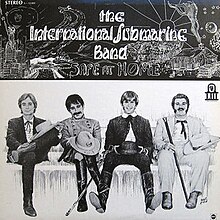Safe at Home
| Safe at Home | |||||
|---|---|---|---|---|---|
 |
|||||
| Studio album by The International Submarine Band | |||||
| Released | March, 1968 | ||||
| Recorded | July–December, 1967 at Western Sound (Studio B) | ||||
| Genre | Country rock | ||||
| Length | 26:19 | ||||
| Label | LHI | ||||
| Producer | Suzi Jane Hokom | ||||
| The International Submarine Band chronology | |||||
|
|||||
| Gram Parsons chronology | |||||
|
|||||
| Professional ratings | |
|---|---|
| Review scores | |
| Source | Rating |
| Allmusic |
|
Safe at Home is a 1968 album by country rock group The International Submarine Band, led by the then-unknown 21-year-old Gram Parsons. The group's only album release, Safe at Home featured four of Parsons' original compositions rounded out by six covers of classic country and rock and roll songs made famous by the likes of Johnny Cash, Elvis Presley, Merle Haggard, and Hank Snow. Described as "hippie and hillbilly in equal measure", the album helped to forge the burgeoning country rock movement of the late 1960s and early 1970s.
Recording of Safe at Home began in July 1967 for Lee Hazlewood's LHI Records, with the group's official lineup consisting solely of Parsons and lead guitarist John Nuese. Rounding out the duo were session drummer Jon Corneal, bassist Joe Osborn, pedal steel guitarist Jay Dee Maness and pianist Earl "Les" Ball, with Hazlewood's girlfriend Suzi Jane Hokom producing. Corneal, a childhood friend of Parsons, soon joined the band as a full member. Recorded during these initial sessions were the Parsons originals "Blue Eyes" and "Luxury Liner", soon issued on a 45 single. The group gigged with the additions of guitarist Bob Buchanan and bassist Chris Ethridge over the next few months. Ethridge and Parsons would play together often in the coming years, with both the Flying Burrito Brothers and the Fallen Angels.
Four months later, with the group's line-up consisting of Parsons, Nuese, Corneal and Buchanan (augmented by Ball, Maness and Ethridge) the group again entered the studio and recorded two new originals, "Strong Boy" and "Do You Know How It Feels To Be Lonesome" along with seven covers, six of which ended up on the original album. By early December, the album was finished and given a target release date of late January or early February 1968, in order to avoid the Christmas rush.
Prior to its release, Parsons left the band after accepting an offer to join The Byrds, and Safe at Home lay dormant for months. According to Corneal, Parsons became so caught up in his new role in The Byrds that he barely acknowledged Safe at Home as its release approached. "I don't think he wanted to look back, but just keep going in the direction he wanted to go", said Corneal. Rock journalist John Einarson surmised decades later that Parsons abandoned his band and his friends without a second thought once the opportunity to join The Byrds was presented to him.
...
Wikipedia
